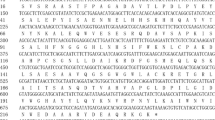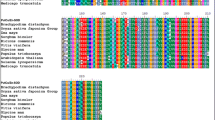Abstract
Here, we present a method for the acquisition of the catalase gene, among the most important enzymes involved in the elimination of reactive oxygen species, from Ulva prolifera, and investigate the relationship of NADPH oxidase, salicylic acid, and high-temperature stress on U. prolifera. The full-length complementary DNA (cDNA) of the catalase gene from the green alga U. prolifera (UpCAT) was cloned by polymerase chain reaction using rapid amplification of cDNA ends. The activity of superoxide dismutase, catalase, NADPH oxidase, and phenylalanine ammonia-lyase and the expression level of UpCAT and glutathione reductase (GR) were investigated following treatment with the NADPH oxidase inhibitor diphenyliodonium and salicylic acid at high temperature. The UpCAT cDNA sequence consisted of 1919 bp containing a 5′-untranslated region of 133 bp, a 3′-untranslated region of 307 bp with a polyA tail, and an open reading frame of 1479 bp encoding a polypeptide of 492 amino acids with molecular weight of 56.88 kDa and theoretical pI of 6.658. The deduced amino acid sequence of UpCAT had significant homology to catalases from other plants. The UpCAT protein sequence contained a proximal heme-ligand signature of 344RIFSYPDTQ352 and a proximal active-site signature of 54FDRERIPERVVHARGAAA71. Additionally, three key residues correlating to catalytic activity, His65, Asn139, and Tyr348, were in the UpCAT sequence. Phylogenetic-tree analysis showed that U. prolifera grouped with Ulva fasciata, Chlamydomonas reinhardtii, Haematococcus pluvialis, and Volvox carteri. Furthermore, we observed that under the high-temperature treatment condition, diphenyliodonium treatment (0.01–0.5 mg L−1) reduced NADPH oxidase activity over the entire time, reduced superoxide dismutase, catalase, and phenylalanine ammonia-lyase activity at the early time and induced the expression of UpCAT. Additionally, the expression level of glutathione reductase was suppressed after DPI (0.5 mg L−1) treatment. Analysis of the UpCAT gene substantially advanced our understanding of green-lineage evolution. The results indicated that NADPH oxidase is involved in the process of salicylic acid-induced alleviation of high-temperature stress; however, the specific mechanism requires further study.








Similar content being viewed by others
References
Achary VMM, Reddy CS, Pandey P, Islam T, Kaul T, Reddy MK (2015) Glutathione reductase a unique enzyme: molecular cloning, expression and biochemical characterization from the stress adapted C4 plant, Pennisetum glaucum (L.). Mol Biol Rep 42:947–962
Apel K, Hirt H (2004) Reactive oxygen species: metabolism, oxidative stress, and signal transduction. Annu Rev Plant Biol 55:373–399
Arnold K, Bordoli L, Kopp J, Schwede T (2006) The swiss-model workspace: a web-based environment for protein structure homology modelling. Bioinformatics 22:195–201
Baxter A, Mittler R, Suzuki N (2013) ROS as key players in plat stress signaling. J Exp Bot 65:1229–1240
Blanc G, Agarkova I, Grimwood J (2012) The genome of the polar eukaryotic microalga Coccomyxa subellipsoidea reveals traits of cold adaptation. Genome Biol 13(5):R39
Chiang CM, Chen SP, Chen LFO, Chiang MC, Chien HL, Lin KH (2014) Expression of the broccoli catalase gene (BoCAT) enhances heat tolerance in transgenic Arabidopsis. J Plant Biochem Biotechnol 23:266–277
de Freitas MB, Stadnik MJ (2015) Ulvan-induced resistance in Arabidopsis thaliana against Alternaria brassicicola requires reactive oxygen species derived from NADPH oxidase. Physiol Mol Plant Pathol 90:49–56
Ding SH, Wang L, Yang ZP, Lu QT, Wen XG, Lu CM (2016) Decreased glutathione reductase2 leads to early leaf senescence in Arabidopsis. J Integr Plant Biol 58(1):29–47
Fan MH, Sun X, Xu NJ, Liao Z, Li YH, Wang JX, Fan YP, Cui DL, Li P, Miao ZL (2017) Integration of deep transcriptome and proteome analyses of salicylic acid regulation high temperature stress in Ulva prolifera. Sci Rep 7:1–19
Fan MH, Sun X, Xu NJ, Liao Z, Wang RX (2016) cDNA cloning, characterization and expression analysis of manganese superoxide dismutase in Ulva prolifera. J Appl Phycol 28:1391–1401
Fan YM, Zhang L, Qin S (2012) Haematococcus pluvialis iron superoxide gene cloning and sequence analysis. Mar Sci 36(4):79–85 (In Chinese)
Guex N, Peitsch MC, Schwede T (2009) Automated comparative protein structure modeling with swiss-model and swiss-pdb viewer: a historical perspective. Electrophoresis 30:S162–S173
Goulas E, Schubert M, Kieselbach T (2006) The chloroplast lumen and stromal proteomes of Arabidopsis thaliana show differential sensitivity to short- and long-term exposure to low temperature. Plant J 47:720–734
Hao FS, Wang XC, Chen J (2005) Involvement of plasma-membrane NADPH oxidase in nickel-induced oxidative stress in roots of wheat seedlings. Plant Sci 170:151–158
Jiang LN, Zhang DJ, Song F, Liu P, Fan TT, Yu HB, Li CX (2014) Evaluation of cold resistance of different wheat varieties based on physiological responses of leaves to low temperature at the jointing stage. Acta Ecol Sinica 31:1064–1072 (In Chinese)
Jia SG, Wang XM, Liu GM (2011) Gene expression analysis of “green tide”alga Ulva prolifera (Chlorophyta) in China. Genes and Genom 33:173–178
Kaur G, Sharma A, Guruprasad K, Pati PK (2014) Versatile roles of plant NADPH oxidases and emerging concepts. Biotech Adv 32:551–563
Kwon SJ, Choi EY, Choi YJ (2006) Proteomics studies of posttranslational modifications in plants. J Exp Bot 57:1547–1551
Kim JY, Park KY, Lee KO, Lee SH (2000) Isolation and characterization of a cDNA encoding a catalase from Chlamydomonas reinhardtii (accession no. AF016902). (PGR00-016). Plant Physiol 122:293–300
Kiefer F, Arnold K, Künzli M, Bordoli L, Schwede T (2009) The swiss-model repository and associated resources. Nucleic Acids Res 37:D387–D392
Laloi C, Apel K, Danon A (2004) Reactive oxygen signalling: the latest news. Curr Opin Plant Biol 7:323–328
Li C, Ni D, Song L, Zhao J, Zhang H, Li L (2008) Molecular cloning and characterization of a catalase gene from zhikong scallop Chlamys farreri. Fish Shellfish Immunol 24:26–34
Li YT, Sommerfeld M, Chen F, Hu Q (2007) Consumption of oxygen by astaxanthin biosynthesis: a protective mechanism against oxidative stress in Haematococcus pluvialis (Chlorophyceae). J Plant Physiol 165:1783–1797
Li YX, Zhang XW, Dong X (2012) Differential gene expression in Ulva prolifera under low light and low temperature conditions. Curr Genet 58:235–244
Livak KJ, Schmittgen TD (2001) Analysis of relative gene expression data using real-time quantitative PCR and the 2−ΔΔCT method. Methods 25:402–408
Liu HM, Zhang HY, Tan ZB (2006) Cloning and expression of catalase-3 gene in Zea mays. J Sichuan Agricult Univ 24(3):272–275 (Chinese)
Marco B, Stefan B, Andrew W, Konstantin A, Gabriel S, Tobias S, Florian K, Tiziano GC, Martino B, Lorenza B, Torsten S (2014) Swiss-model: modelling protein tertiary and quaternary structure using evolutionary information. Nucleic Acids Res 42:W252–W258
Ma CL, Wang PP, Cao ZY, ZhaoYX (2003) Cloning and differential gene expression of two catalases in Suaeda salsa in response to salt stress. Acta Bot Sinica 45:93–97
Pombert JF, Blouin NA, Lane C, Boucias D, Keeling PJ (2014) A lack of parasitic reduction in the obligate parasitic green alga Helicosporidium. PLoS Genet 10(5):e1004355
Prochnik SE, Umen J, Nedelcu AM, Hallmann A Miller SM, Nishii I, Ferris P, Kuo A, Mitros T, Fritz-Laylin LK, Hellsten U, Chapman J, Simakov O, Rensing SA, Terry A, Pangilinan J, Kapitonov V, Jurka J, Salamov A, Shapiro H, Schmutz J, Grimwood J, Lindquist E, Lucas S, Grigoriev IV, Schmitt R, Kirk D, Rokhsar DS (2010) Genomic analysis of organismal complexity in the multicellular green alga Volvox carteri. Science 329(5988):223–226
Provasoli L (1968) Media and prospect for the cultivation of marine algae. Proc USA Japan Conf Hakone Jap Soc Plant Physiol pp 63–75
Rafacho BPM, Azevedo PS, Polegato BF, AAH F, Bertoline MA, Fernandes DC, Fernanda CM, Roscani MG, dos Santos PP, Matsubara LS, Matsubara BB, Laurindo FRM, Paiva SAR, Zornoff LAM, Minicucci MF (2011) Tobacco smoke induces ventricular remodeling associated with an increase in NADPH oxidase activity. Cell Physiol Biochem 27:305–312
Shi QH, Bao ZY, Zhu ZJ, Ying QS, Qian QQ (2006) Effects of different treatments of salicylic acid on heat tolerance chlorophyll fluorescence, and antioxidant enzyme activity in seedlings of Cucumis sativa L. Plant Growth Regul 48:127–135
Suzuki N, Miller G, Morales J, Shulaev V, Torres MA, Mittler R (2011) Respiratory burst oxidases: the engines of ROS signaling. Curr Opin Plant Biol 14:691–699
Sung MS, Hsu YT, Wu TM, Lee TM (2009) Hypersalinity and hydrogen peroxide upregulation of gene expression of antioxidant enzymes in Ulva fasciata against oxidative stress. Mar Biotechnol 11:199–209
Wu TM, Hsu YT, Sung MS (2009) Expression of genes involved in redox homeostasis and antioxidant defense in a marine macroalgae Ulva fasciata by excess copper. Aquat Toxicol 94:275–285
Wang JX, Milton S, Hu Q (2011) Cloning and expression of isoenzymes of superoxide dismutase in Haematococcus pluvialis (Chlorophyceae) under oxidative stress. J Appl Phycol 23:995–1003
Wahid A, Gelani S, Ashraf M, Foolad M (2007) Heat tolerance in plants: an overview. Environ Experiment Bot 61:199–223
Wang SB, Chen F, Sommerfeld M, Hu Q (2004) Proteomic analysis of molecular response to oxidative stress by the green alga Haematococcus pluvialis (Chlorophyceae). Planta 220:17–29
Xiong WG, Sun YX, Zou MJ, Muhammad RUH (2013) Molecular cloning, characterization of CAT, and eco-toxicological effects of dietary zinc oxide on antioxidant enzymes in Eisenia fetida. Environ Sci Pollut Res 20:1746–1755
Xu Y, Gianfagna T, Huang B (2010) Proteomic change associated with expression of a gene controlling cytokinin synthesis for improving heat tolerance in a perennial grass species. J Exp Bot 61:3273–3289
Zhang L, Fan YM, Shi F, Qin S, Liu B (2012) Molecular cloning, characterization, and expression analysis of a cytosolic hsp90 gene from Haematococcus pluvialis. J Appl Phycol 24:1601–1612
Zhang PY, Liu SH, Chen KS (2013) Characterization and expression analysis of a glutathione reductase gene from Antarctic moss Pohlia nutans. Plant Mol Biol Rep 31:1068–1076
Zhu ZB, Sun X, Xu NJ, Luo QJ (2012) Effects of salicylic acid on the resistance of Gracilaria/Gracilariopsis lemaneiformis to high temperature. J Fish China 36(8):1304–1312
Funding
The National Natural Science Foundation of China (No. 40876073 and No. 41276122), the Research Fund for the Doctoral Program of Higher Education of China (20123305110002), and Doctoral Research Fund of Zhejiang Ocean University (Q1701) supported this study.
Author information
Authors and Affiliations
Contributions
Conceived and designed the experiments: MF, NX. Performed the experiments: MF, ZL. Analyzed the data: XS, MF, DC. Contributed reagents/materials/analysis tools: JW, ZL. Wrote the paper: MF.
Corresponding authors
Rights and permissions
About this article
Cite this article
Fan, M., Sun, X., Liao, Z. et al. Full-length cDNA cloning, characterization of catalase from Ulva prolifera and antioxidant response to diphenyliodonium. J Appl Phycol 30, 3361–3372 (2018). https://doi.org/10.1007/s10811-018-1567-2
Received:
Revised:
Accepted:
Published:
Issue Date:
DOI: https://doi.org/10.1007/s10811-018-1567-2




